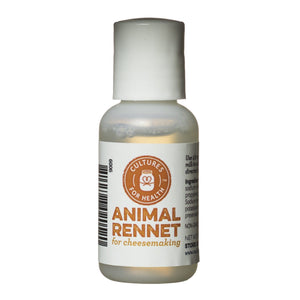Gruyère is a sweet, slightly salty cheese from Switzerland. The flavor can vary as the cheese ages, becoming earthier and more complex. This cheese recipe requires pressing, aging, and is a bit more intensive, so be prepared to set some time aside when you decide to make gruyère at home.
20 minutes
180 minutes
5
INGREDIENTS AND EQUIPMENT AVAILABLE AT CULTURES FOR HEALTH
Fresh Cheese Making Kit

Fresh Cheese Making Kit
$45.99
Our most comprehensive choice, the Fresh Cheese Kit contains two starter cultures and supplies to make five different varieties of soft cheese - feta, cottage cheese, cream cheese, fromage blanc, and traditional quark. Kit contains a Mesophilic Cheese Culture, a Fresh Cheese Culture, calcium chloride, vegetable rennet, cheese salt, butter muslin, a thermometer, and an instruction and recipe booklet.
Packaging and Equipment in the kit may appear different than pictured.
Propionibacteria Cheese Starter Culture
Thermophilic C Culture
Liquid Animal Rennet

Liquid Animal Rennet
$9.49
High quality single strength animal rennet. This non-GMO animal rennet is preferred for aged cheese as it creates a more desirable flavor and aroma during the aging process. Each bottle contains enough rennet to set (12) 2-gallon batches of cheese.
Grey Celtic Sea Salt
EQUIPMENT:
- Stainless steel pot
- Glass measuring cup
- Digital Thermometer
- Large slotted spoon
- Cheese knife
- Cheesecloth
-
Cheese press with 2-lb. mold
INGREDIENTS:
- 2 gallons whole milk (avoid UHT or ultra-pasteurized milk)
- 1 heaping teaspoon propionic shermanii culture
- 1/4 teaspoon thermophilic type C culture
- 1/2 tsp. liquid animal rennet
- 1 cup sea salt
- 1/2 gallon + 1/4 cup (separated) unchlorinated water
INSTRUCTIONS:
- Dissolve Propionic Shermanii in 1 cup of milk. In a large pot, heat the remaining milk slowly to 92°F.
- Turn off heat, and add in the thermophilic culture. Stir for 1 minute.
- Add Propionic Shermanii/milk mixture. Stir for an additional 30 seconds. Cover, and let set for 15 minutes.
- Stir thoroughly, then gently stir the rennet into 1/4 cup water. Begin adding rennet/water mixture to the milk mixture. This should take 30 seconds, using an up-and-down motion. Continue to stir, using up-and-down motion, for an additional 30 seconds. Cover and let set for 45-55 minutes, or until you get a clean break with a cheese knife.
- When the curds are thick and shiny, with a clear layer of whey on the top and a clean break, use a long knife to cut them into 1/4- to 1/2-inch cubes.
- Stir for 40 minutes, keeping the temperature between 90° and 92°F.
- Turn heat to low and raise the temperature of the curds and whey to 120°F. This should take 20-30 minutes. Continue to stir, both to prevent matting and to release as much whey from the curds as possible.
- When the curds have reached 120°F, turn off the heat and stir for another 30 minutes.
- Drain into a cheesecloth-lined mold and press at 10 pounds for 20 minutes. Remove cheese from mold, turn over, redress, and press at 15 pounds for 30 minutes. Repeat, pressing at 30 pounds for 6 hours and then at 50 pounds for 12 hours.
- Make a strong brine by dissolving the sea salt in the water.
- After 12 hours, remove cheese from mold, unwrap, and place in strong brine for 12 hours, turning several times. Age at 55°F, 85% humidity, for 6 months or more, turning regularly and wiping any mold away with a clean cloth dampened with brine.
*This recipes has not been tested with vegetable rennet.

















